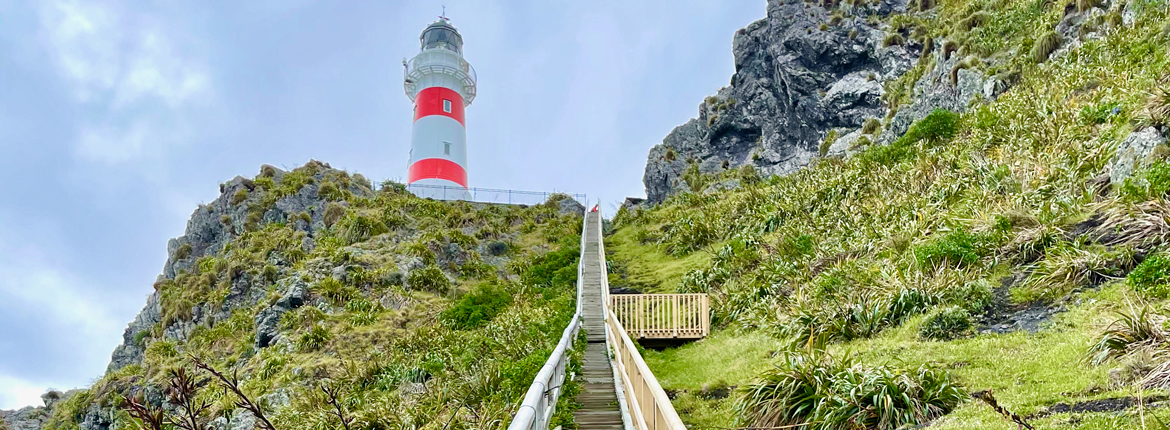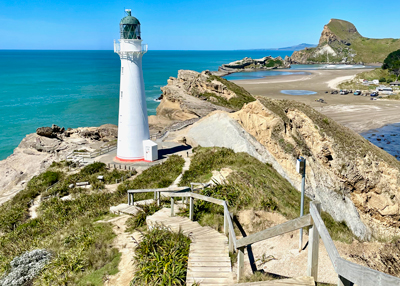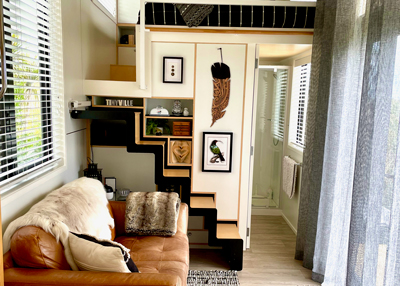
Points in the landscape
Jo Percival follows the southern coast of the North Island.
There is something gravitational about lighthouses. They’re the pinpoints on a map marking wild and interesting spots, rich with stories and the whiff of historic danger. However, for this road trip,
I begin my journey not with a lighthouse but a windmill. It’s impossible to miss De Molen, the full-scale replica of a 17th Century Dutch windmill, standing alongside Foxton’s main street. De Molen means ‘The Mill’ in Dutch, and the windmill still grinds flour today using the same technology from centuries ago.
De Molen is just part of Foxton’s Te Awahou Niuewe Stroom cultural precinct – the only tri-lingual cultural institution in New Zealand, with signage throughout the expansive museum and gallery in English, Māori and Dutch.
Exploring the exhibits, I am astonished to learn just how much influence the Dutch had in introducing the things we take for granted in New Zealand today. Paramount in bringing exotic cheeses and cured meats to the country, they were also pioneers of New Zealand’s early coffee house culture, back in the days when tea drinking reigned supreme. I pay tribute to the culinary trailblazers by stocking up on Gouda and smoked sausage from the shop in the base of the windmill.

On the road south from Foxton I pass hand-painted signs advertising locally grown produce for sale; one advises to “toot in the driveway” for service. I buy garden-fresh vegetables, along with a bottle of ruby-red pinot noir from the cellar door at Ōhau Wines, to make up my dinner.
At the Tiny House where I’ll be staying the night at Waikawa Beach, a trio of rabbits lollop lazily across the front lawn and I hear the rusty squawk of a pheasant in the sand dunes. As I unload my car, an elderly man walks back from the beach with a handful of toetoe and nods hello. “Someone asked me to get them for decorations,” he explains, assessing the fronds glumly. “But they’re not looking so great. Bit mouldy,” he shrugs. “At least I tried!”
As I explore the beach, the clouds split, spilling shimmering silver streaks across the sea. The haunches of Kāpiti Island sit on the southern horizon. I retreat to the warmth of the Tiny House. In the morning, I continue south. The navy blue Tararua Ranges lurk in my peripheral vision like a sullen teenager, draped in a grey gauze of clouds.
Heading towards Wellington City, it is aggressively wet. This is not outdoor weather. Abandoning my plan to explore the Capital’s rugged southern coast, I instead hop puddles and scuttle around hunch-shouldered pedestrians on Cuba Street to find a warm café for lunch.
I browse art galleries; spray perfume samples on my wrists and smell like a stranger to myself. On Willis Street, amidst the rumble of buses, a busker plays a haunting melody on a steel drum which resonates and fills the rainy street with a soothing, meditative calm.
The following day I head north, skirting the edge of the frothy, coffee-coloured harbour, swollen with rain.
The motorway carves through the Hutt Valley alongside the eponymous river, roiling like shiny toffee.
On the other side of the Remutaka Ranges, C’est Cheese in Featherston has been recently transformed from a tiny shop into a full-scale deli, café and cheese bar, where Remutaka Pass products are made onsite. I’m told they focus mainly on blue cheeses and washed rind, the latter created in collaboration with Martinborough wineries, using their wines to create the wash. I add a selection to the stash in my chilly bin.
Featherston is also a ‘Booktown.’ With seven bookstores, Featherston has – for its size and population – more bookstores than anywhere else in New Zealand. From English literature to military history and children’s fiction, the literary bases are well covered. On this quiet morning, many of the shops are shut and I am left to squint wistfully into dark windows, vowing to come back for a weekend visit.
Arriving at Lake Ōnoke on the southern coast, the cloud thins to tepid sunshine. I pass modest baches named things like ‘Lazy Daze’ and ‘Boonsville,’ with hardy, succulent-filled gardens and driftwood borders. In the distance, Palliser Bay is a sheet of crumpled aluminium foil. The Lake Ferry Hotel is packed with tourists. I order the pub’s famous fish and chips and eat sitting next to the fire crackling in the corner.
Driving further south, small settlements cling to the rocky coast. The road is scarred by slips and washouts, with signs advising to proceed with EXTREME caution. Further along, stock graze the grass verge next to the sea, wandering placidly across the road. In Ngawi, next to the famous beachful of bulldozers, a cow munches on the hedge outside a weatherbeaten Fibrolite bach.
Towards Cape Palliser, sheep are joined by seals lying so close to the gravel road they are at genuine risk of being run over. I open the car door and one yawns ambivalently at me from just metres away.

Finally, the lighthouse emerges as I round the last headland, its distinctive red and white stripes dwarfed by the cliffs behind it. There are 252 steps to reach the lighthouse. My fingers fizz as I climb higher, holding tightly to the wooden railing. At the top I stop to catch my breath and talk to the two maintenance workers – today’s lighthouse keepers – working on the site. It’s lucky timing; they’re only onsite twice a year, and offer me the chance to look inside. I climb even more steps – steeper and metal – to marvel at the original Fresnel lens of the light itself. Made in England in the 1800s, its layers of beautiful carved class refract the rotating light through a glass ‘bullseye’ which generates the pattern of flashes – twice every 20 seconds – that can be seen for 26 nautical miles.
In the morning, my heart lightens as, finally, I set off into a shining blue-sky day, crystal and clear. Everything seems to shimmer, washed clean by days of rain.
My first stop in Greytown is at a cute cottage that’s home to a small chocolate factory creating remarkably innovative confectionary. Schoc Chocolates has been in business for 19 years and has perfected the art of ‘chocology’ with its award-winning flavours. I sample shards of chocolate at the counter: ‘Fennel’ has an aniseed zing. ‘Apricot and Rosemary’ evokes a Sunday roast chicken. And who would have thought that a ‘Curry and Poppadom’ flavoured chocolate could be so delicious?
Unfurling in the sunshine, Tikara Country Gardens on the outskirts of nearby Carterton is a heavenly five-acre site filled with fragrant and colourful blooms. The passion project of Mary McCullum, Tikara was established 11 years ago when Mary and her husband Bruce fell in love with the sweeping views of the Tararua Ranges and built what is now one of Wairarapa’s loveliest spots for a wander. The gardens are filled with neat rows of burgundy Japanese Maples, magnolias, colourful lupins, irises and sweet-smelling roses that seem to be enjoying the sunny day as much as I am.
Later, I arrive at Castlepoint Holiday Park, a slice of pōhutukawa-packed, tūī-filled Kiwiana, with grandstand views of Wairarapa’s other famous lighthouse, sitting like a discarded chess piece on the headland. The beachfront site is postcard-perfect, with perfectly blue sea and crisp white waves on a windless afternoon.
The pace is like molasses. Couples smile in camp chairs, soaking up the sun. A man ambles slowly back from the beach. It is comfortable, communal, convivial.
On my final morning, I explore Castlepoint’s jumble of geology. Smooth, barnacle-crusted rocks, cracked and warped into terraces, cliffs and headlands that curve around powdery sand dunes and the shallow, tropical-looking waters of the lagoon. I walk along the briny cliffs where gaps in the rock funnel waves in dramatic surges to fill the lagoon. Further along, seals are disguised as dark clumps of seaweed. I stop at a crevice churning with sea foam and notice a seal pup close by, watching me from the seaward edge of the cliff.
The tidal lagoon has shrunk to half its size by the time I’ve circumnavigated the white lighthouse, basked in the sunshine and drunk in the magnificent views all the way north to Cape Turnagain. I wonder if there is a lighthouse there, too.
Walking back along the hard sand I have birds in stereo – the plaintive wail of seagulls on one side, a cacophony of tūī on the other. But I have to leave, reluctantly, with sandy feet and smelling of sunshine, for the drive home.
Reported by Jo Percival for our AA Directions Autumn 2021 issue
